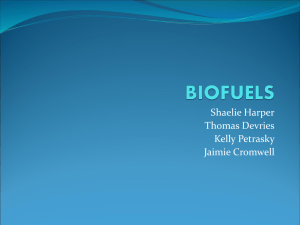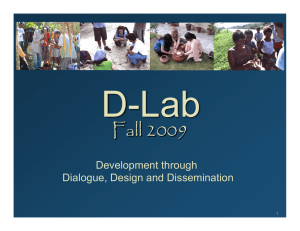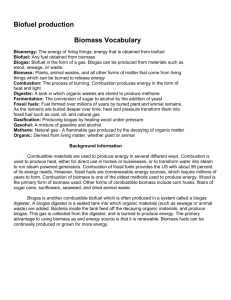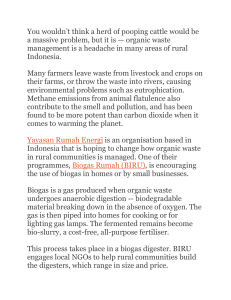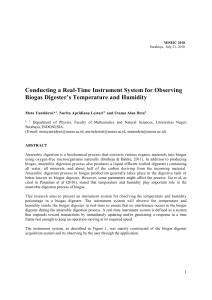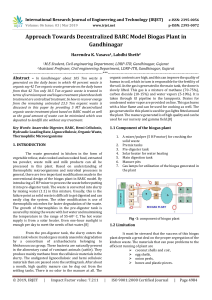SP.723: D-Lab III: Dissemination: Implementing Innovations for the Common Good
advertisement
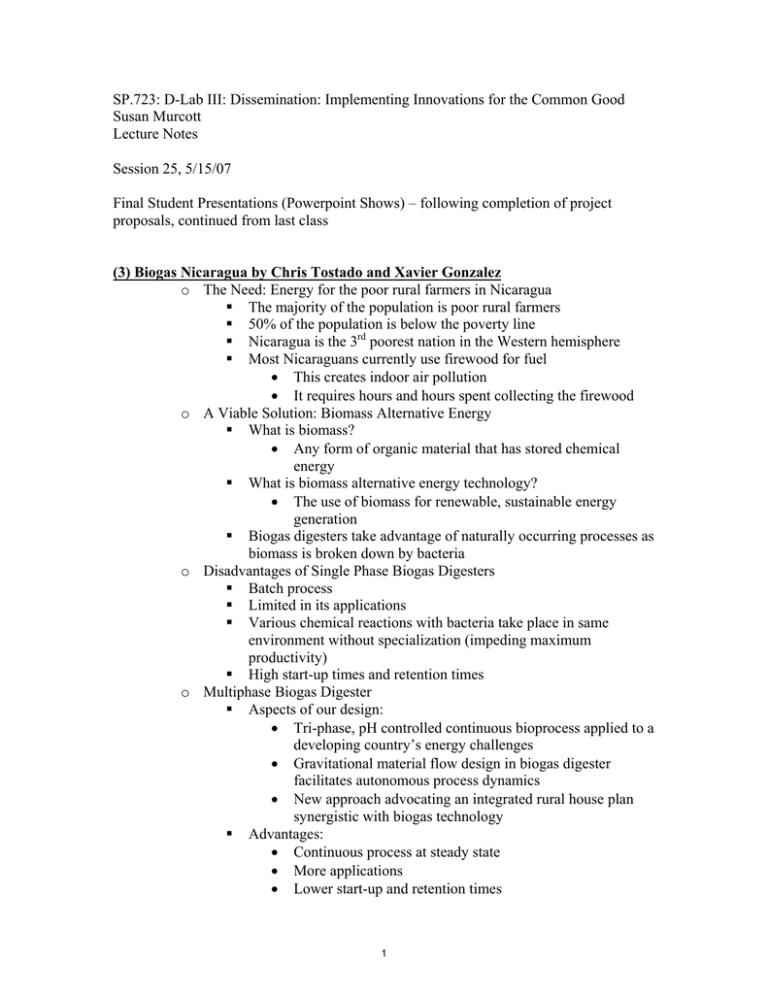
SP.723: D-Lab III: Dissemination: Implementing Innovations for the Common Good Susan Murcott Lecture Notes Session 25, 5/15/07 Final Student Presentations (Powerpoint Shows) – following completion of project proposals, continued from last class (3) Biogas Nicaragua by Chris Tostado and Xavier Gonzalez o The Need: Energy for the poor rural farmers in Nicaragua The majority of the population is poor rural farmers 50% of the population is below the poverty line Nicaragua is the 3rd poorest nation in the Western hemisphere Most Nicaraguans currently use firewood for fuel • This creates indoor air pollution • It requires hours and hours spent collecting the firewood o A Viable Solution: Biomass Alternative Energy What is biomass? • Any form of organic material that has stored chemical energy What is biomass alternative energy technology? • The use of biomass for renewable, sustainable energy generation Biogas digesters take advantage of naturally occurring processes as biomass is broken down by bacteria o Disadvantages of Single Phase Biogas Digesters Batch process Limited in its applications Various chemical reactions with bacteria take place in same environment without specialization (impeding maximum productivity) High start-up times and retention times o Multiphase Biogas Digester Aspects of our design: • Tri-phase, pH controlled continuous bioprocess applied to a developing country’s energy challenges • Gravitational material flow design in biogas digester facilitates autonomous process dynamics • New approach advocating an integrated rural house plan synergistic with biogas technology Advantages: • Continuous process at steady state • More applications • Lower start-up and retention times 1 o o o o o o • More methane per volume of manure • Greater benefit to cost ratio • Interchangeable parts make it more modular Integrating energy system with local housing infrastructure We want people to think about the design of their housing so that it can be more synergistic with biogas technology Our prototype biogas digester Potential project phases (We have a 5-10 year plan. This summer we will be primarily focused on phase 1 and setting up for phase 2.) Phase 1: building and testing full scale prototype Phase 2: Symposium and exhibition with model kitchen Phase 3: Dissemination to surrounding regions Phase 4: Company for manufacturing of modular biogas kit and replacement parts Summer 2007 Goals Completion of Phase 1 and setting up of Phase 2 • Make contact and schedule with team members from UNA • Choose site (on reserve), plan, design, acquire local building materials, and build a full-scale biogas digester prototype. Troubleshoot design and building problems, and test digester. • Design and build small model Nicaraguan kitchen to test the connectivity of the digester and the convenience and compatibility of local rural farmers. • Document (with video) everything we do and keep a detailed lab manual for future research and installations • Make a strategic short term 2 year plan with our community partners for continuation of project. Target community and partners We’ll be staying on the coast Rancho Guadalupe The grad student we’re working with will be in Managua this summer Pictures of the area (4) DataHealth Pakistan: Disease Mapping in Lahore Pakistan by Ali Alhassani and Ibrahim Kanan o Motivation Desire to apply statistics knowledge to serve those in need Simple Techniques can be used to prevent many needless morbidities and mortalities Desire to bring healthcare services to the underserved o Why Lahore, Pakistan? Over 250,000 deaths due to diarrhea 2 o o o o o o Over 300,000 deaths due to diseases such as TB, measles, whooping cough, and pneumonia Health expenditure per capita was $15 in 1999 and $13 in 2003 National Health Management Information Systems (NHMIS) Project Overview: Innovative Data Tracking Uses data from public hospitals and cross references it with socioeconomic information Constructs maps that identify highly vulnerable communities Targets vulnerable communities for improved healthcare Phase I: Data Interface Phase II: Data Analysis Phase III: Reporting findings to guide community-based efforts Budget Community Partners and Future Outlook Advisory board: • John Guttag • Jonathan Rosen, MD • Susan Murcott Lahore Hospital Partners: • Shalimar Hospital • Gulab Devi Hospital $5000 in capital raised so far Two team members traveling to Lahore this summer Data collection to begin… (5) Vac-Cast Prosthetics by Tess Veuthey o Team members o Project summary o Problem There are more than 10 million amputees worldwide, and most of them are living below the poverty line o Community Partner: Jaipur Foot o Current Technology: Plaster of Paris Wasteful, takes 3-5 hours per socket o Current technology: Vacuum sand casting Far more efficient, but not portable o Our solution: portable human powered vacuum sand casting This could create a 5-fold increase in patient throughput o We won an IDEAS grant to put our project into use. o We’re thinking of expanding our program at MIT and creating a seminar class in rehabilitation here (6) New Dots by Angela Kirby (project presentation not recorded in these notes) (7) EVCO-Heating Schools in Lesotho by Tamira Gunzberg (project presentation not recorded) 3 MIT OpenCourseWare http://ocw.mit.edu EC.715 D-Lab: Disseminating Innovations for the Common Good Spring 2007 For information about citing these materials or our Terms of Use, visit: http://ocw.mit.edu/terms.

